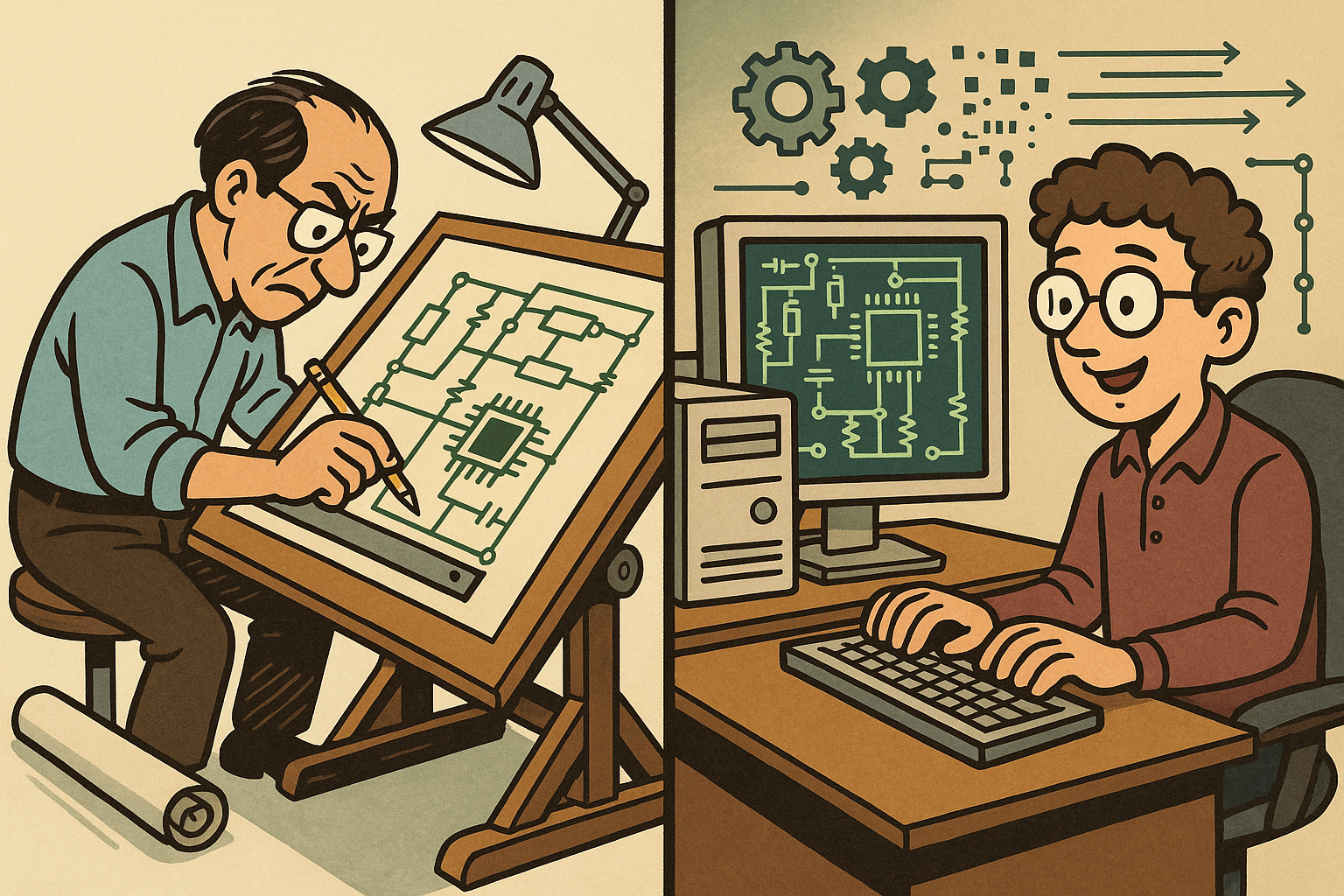Your Cart is Empty
Customer Testimonials
-
"Great customer service. The folks at Novedge were super helpful in navigating a somewhat complicated order including software upgrades and serial numbers in various stages of inactivity. They were friendly and helpful throughout the process.."
Ruben Ruckmark
"Quick & very helpful. We have been using Novedge for years and are very happy with their quick service when we need to make a purchase and excellent support resolving any issues."
Will Woodson
"Scott is the best. He reminds me about subscriptions dates, guides me in the correct direction for updates. He always responds promptly to me. He is literally the reason I continue to work with Novedge and will do so in the future."
Edward Mchugh
"Calvin Lok is “the man”. After my purchase of Sketchup 2021, he called me and provided step-by-step instructions to ease me through difficulties I was having with the setup of my new software."
Mike Borzage
Design Software History: Early Electronics CAD: From Manual Drafting to Algorithm-Driven Design and Its Impact on the Industry
October 02, 2025 10 min read


Early Beginnings in Electronics CAD – An Overview of Pre-CAD Design
Traditional Methods and the Landscape of Early Electronics Design
In the era preceding computer‐aided design, the field of electronics was dominated by painstaking manual techniques. Engineers and designers relied heavily on traditional hand‐drafting methods that required precision, endurance, and a significant investment of time. During these early days, every schematic and printed circuit board (PCB) layout was meticulously drawn by hand using tools such as pencils, drafting tables, and rulers. This meant that even minor adjustments required erasure and redrawing, often resulting in considerable delays. In addition, design teams typically had to collaborate using physical blueprints and hand‐written notes, making the communication of complex ideas more challenging. The environment was characterized by the following features:- Manual Hand-Drafting: All schematics and layouts were drawn by hand, leaving little room for rapid iteration.
- Precision and Rework Issues: Revisions were prone to error, and even a small miscalculation required redrafting entire sections.
- Limited Collaboration: Documentation was localized and unable to be shared electronically, hindering efficient teamwork.
The Challenges and Constraints of a Manual Process
The analog nature of early electronics design imposed severe challenges on the industry. Without the benefit of digital automation, engineers had to spend long hours perfecting every detail by hand. The physical limitations of traditional drafting tools meant that every minute detail required concentration and significant time investment. The painstaking process also made it difficult to explore alternative design solutions quickly, and iterative processes were both conceptually and practically cumbersome. Moreover, the reliance on paper and physical blueprints created a scenario where the integration of new ideas, revisions, and collaborations among interdisciplinary teams was slow and error-prone. The limitations that defined this era included a lack of standardization, difficulties in reproducing designs accurately, and the absence of dynamic feedback during the design process. All these factors contributed to an industrial environment where innovation was often stalled by the protracted nature of manual revisions and physical documentation. Gradually, this scenario began to change as the promise of digital computation started to emerge, hinting at transformative potential in design practices that would ultimately pave the way for the adoption of Computer-Aided Design tools.Early Beginnings in Electronics CAD – The Emergence of Computing and Algorithm-Driven Design
Transition from Manual Drafting to Algorithmic Assistance
The advent of computing technology marked a revolutionary turning point for the electronics design industry. Early computers, though limited by today’s standards, were capable of performing calculations at speeds unimaginable with manual methods. This shift enabled the gradual replacement of traditional drafting with algorithm-driven design tools. Pioneering software developers began experimenting with algorithms to automate repetitive tasks, which allowed designers to explore complex circuit topologies much faster. Early applications of these technologies included basic schematic capture systems and rudimentary PCB layout programs that provided a digital canvas on which engineers could work. The benefits of this shift were many, such as increased productivity, reduced errors, and the ability to simulate and validate design ideas before committing them to physical prototypes. This transition was underpinned by the advent of digital logic and the use of simplistic computer-aided methods that introduced a level of precision and repeatability previously unattainable.Pioneering Software Developments in Early Digital Design
With the introduction of computing, the electronics industry began to explore new possibilities that extended far beyond manual techniques. Developers started crafting software that could handle tasks like automated layout and schematic verification, elements that were once laborious and time-consuming. Early software prototypes laid the groundwork for the creation of more advanced design tools, setting a foundation that would later support complex simulation and modeling techniques. This digital revolution was encapsulated by significant milestones such as the implementation of basic graphic user interfaces and the integration of algorithm-driven validation methods. Engineers soon found that digital tools not only minimized errors but also allowed for the rapid iteration of design ideas—which in turn stimulated further innovation in matched hardware solutions. The resulting paradigm shift not only improved the day-to-day workflow but also redefined the role of design engineers, who moved from being mere draftsmen to becoming thinkers capable of leveraging **algorithm-driven designs** to solve intricate engineering challenges. The transformation marked a significant step in the evolution of electronics design, as it forged an enduring partnership between computer technology and engineering disciplines.Milestones and Innovations in CAD for Electronics and PCB Design – Technological Breakthroughs in the Field
Key Technological Breakthroughs and Automation Strategies
As computer-aided design began to mature, the electronics industry experienced a series of technological breakthroughs that fundamentally reshaped the design landscape. One of the seminal developments was the automation of schematic capture and PCB layout processes. Tools were engineered to automatically detect and correct errors, effectively integrating design rule check (DRC) systems that ensured reliability throughout the design process. Innovations such as auto-routing further simplified the task of connecting components on a board. These tools leveraged the power of early computing to provide more accurate interconnections and optimize component placement—a dramatic improvement over manual methods. This breakthrough was not an isolated development, but rather a part of a broader transformation that saw electronics design evolve from a craft into a systematic engineering discipline. Key technological innovations during this period included:- Schematic Capture Systems: Software capable of converting hand-drawn or manually entered schematics into a digital format.
- Layout Automation Tools: Systems that automated the positioning and routing processes, enhancing overall design speed.
- Design Rule Checking: Integrated validation systems that preemptively identified design anomalies and inconsistencies.
Advancements in Schematic Capture and Routing Technologies
Further advancements in CAD technology were realized with the introduction of specialized features aimed at streamlining the design process. The development of schematic capture software provided engineers with digital tools to create and manipulate circuit diagrams efficiently. This breakthrough allowed for more consistent documentation and easier modifications of intricate designs. In parallel, auto-routing algorithms became a focal point for innovation. These algorithms were designed to automatically connect components according to pre-defined design rules, a major leap forward from tedious manual routing. This integration of digital tools culminated in systems capable of performing complex routing tasks while simultaneously checking for potential design conflicts. The convergence of these capabilities meant that designers could now focus more on higher-level conceptual challenges rather than getting bogged down by repetitive details. When combined with early simulation tools, these innovations signaled the transition from static, manual drafting to dynamic, adaptable, and highly efficient electronic design automation systems. Designers began to recognize the duality of these advancements—not only as a means to boost productivity but also as a way to improve the overall robustness and functionality of electronic devices.Influential Figures and Corporate Trailblazers in CAD Development
The rapid evolution of CAD systems was fueled by contributions from notable companies and visionary individuals. Industry leaders invested significant resources in research and development, leading to a period of rapid innovation that transformed the design process. Pioneering companies such as Mentor Graphics, Cadence Design Systems, and Altium played critical roles in advancing CAD technologies, introducing features that eventually became industry standards. These companies not only developed groundbreaking software but also fostered a collaborative environment where ideas could be shared across disciplinary boundaries. Alongside these corporate giants, a number of influential engineers and software developers provided key insights that further propelled the industry forward. Their work on early algorithms, error-checking protocols, and layout optimizations paved the way for the next generation of design tools. Recognized for their contributions were individuals who, through rigorous experimentation and relentless innovation, helped shape the CAD landscape. The contributions of these trailblazers can be summarized by several key points:- Innovative Software Development: Pioneering individuals who developed algorithms that became the backbone of modern CAD systems.
- Corporate Investment in R&D: Companies that heavily funded CAD research and pushed the boundaries of what was possible in electronics design.
- Collaborative Advancements: The culture of innovation and shared expertise that propelled the industry into a new era of design proficiency.
Impact on the Electronics Design Process and Industry – Transforming Workflows and Manufacturing
Revolutionizing the Design Workflow
The introduction of computer-aided design technologies precipitated a complete transformation of the electronics design workflow. This new paradigm allowed for a meticulous integration of design, verification, and manufacturing processes that was previously impossible with manual methods. With the assistance of digital tools, engineers could now generate and modify designs with a level of precision and speed that dramatically reduced the time-to-market for new electronic products. The automation of critical tasks such as schematic capture and auto-routing minimized human error and improved overall design consistency. Moreover, this transition enhances collaboration between different engineering disciplines. Software platforms began incorporating features that facilitated the sharing of design data between electrical, mechanical, and even software engineers. Such integration was bolstered by the arrival of simulation modules that could validate design integrity in real-time, ensuring that prototypes met stringent performance standards before moving into production. The evolution of these integrated workflows can be broken down into several defining characteristics:- Enhanced Efficiency: Automation reduced redundant tasks, allowing engineers to focus on innovation.
- Improved Accuracy: Digital tools offered stringent error checking and real-time validation.
- Streamlined Collaboration: Unified platforms enabled seamless data exchange between interdisciplinary teams.
Integration with Simulation and Advanced Prototyping
In the era of digital design, simulation tools became an integral part of the design process. These applications allowed engineers to emulate how electronic circuits would behave in various operating conditions. Prior to integrating simulation into CAD platforms, validating a design’s performance required building physical prototypes—a process that was both time-consuming and expensive. With simulation software in place, designers could identify potential issues in a virtual environment, iterating on their designs with unprecedented speed. The feedback provided by these simulation tools not only improved confidence in design decisions but also contributed to an increase in overall product reliability. Additionally, the combination of design automation and simulation paved the way for innovative prototyping techniques. Each simulation cycle enabled precise modifications and iterative testing, thereby reducing the dependency on costly revisions during manufacturing. The integration of these systems led to a clear set of benefits:- Real-Time Design Validation: Immediate simulation feedback allowed for a proactive approach to quality control.
- Cost Reduction: Virtual testing minimized prototyping expenses and streamlined the development cycle.
- Accelerated Innovation: Rapid iterations empowered engineers to explore novel design solutions with confidence.
Long-Term Industry Impact and Collaborative Advancements
Beyond immediate workflow improvements, the widespread adoption of computer-aided design spawned enduring changes in the electronics manufacturing industry. The introduction of standardized digital design protocols fostered better collaboration across traditionally siloed engineering disciplines. By using common data formats and shared design rules, teams worldwide were enabled to work in unison, effectively reducing miscommunication and streamlining project timelines. Furthermore, these digital design systems laid the groundwork for the adoption of advanced manufacturing techniques, such as computer numerical control (CNC) machining and, later, additive manufacturing. The legacy of early CAD innovations is evident in the continuing evolution of design standards that emphasize interoperability, modularity, and design reuse. A few of the core benefits that emerged from these innovations include:- Improved Collaboration: Unified platforms and common design protocols enabled seamless interdisciplinary work environments.
- Standardization: Adoption of consistent design practices led to a high degree of reliability and quality control in production.
- Global Interoperability: Standard data formats allowed engineers from across the world to collaborate effectively, accelerating progress in electronics manufacturing.
Conclusion – Reflecting on the Evolution, Its Significance, and Future Trends
Recap of CAD Evolution in Electronics and PCB Design
The journey from manual hand-drafting to sophisticated computer-aided design systems represents one of the most profound transformations in the history of electronics engineering. Early innovators overcame significant challenges by leveraging the emerging power of digital computation, setting in motion a sequence of technological advancements that revolutionized the industry. The evolution of CAD in electronics has had a cascading effect—from the introduction of **automated schematic capture** and layout tools to the development of robust design rule checking, auto-routing, and simulation integration. These innovations have not only accelerated the design cycle but also improved accuracy, fostered interdisciplinary collaboration, and established industry-wide standards that continue to influence modern design practices. The influence of CAD technology remains profoundly evident in today's design workflows and industrial manufacturing, highlighting a legacy defined by continuous improvement and relentless innovation.Looking Ahead: Future Trends and Ongoing Transformations
As the digital era advances further, the legacy of early CAD innovations in electronics design serves as a robust foundation for future progress. Today, emerging trends such as **machine learning**, artificial intelligence, and cloud-based solutions are poised to push the boundaries of design automation even further. These cutting-edge technologies are anticipated to further enhance the capabilities of design software, offering unprecedented levels of simulation accuracy, design optimization, and predictive maintenance. Engineers around the world are now exploring how these modern tools can be seamlessly integrated into existing workflows to drive innovation and maintain competitive edges in a rapidly evolving market. The convergence of AI-driven algorithms with traditional CAD systems is expected to result in intelligent design assistants capable of predicting errors, suggesting optimizations, and automating intricate tasks that once required human intuition. Additionally, the growing reliance on cloud-based platforms will facilitate global collaboration and secure data sharing, ensuring that the design process remains agile, scalable, and increasingly efficient. In summary, the evolution of CAD has not only redefined the way electronic and PCB designs are executed but also set the stage for an exciting future where technology, creativity, and engineering excellence continue to propel the industry to new heights.Also in Design News

Embracing Data-Driven Design: Revolutionizing Product Development with Advanced Analytics
October 02, 2025 12 min read
Read More
Cinema 4D Tip: Streamline Scene Management in Cinema 4D with the Stage Object
October 02, 2025 3 min read
Read More
Bluebeam Tip: Optimizing Document Workflow with Bluebeam Revu's Text Recognition Feature
October 02, 2025 2 min read
Read MoreSubscribe
Sign up to get the latest on sales, new releases and more …


